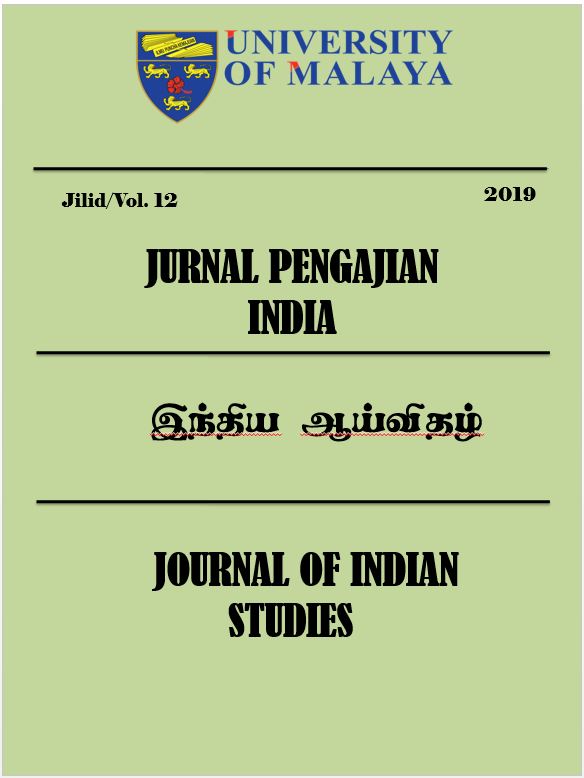சிந்துவெளி நாகரிகம் ஓர் ஆய்வியல் அறிமுகம் (An Introduction to the Indus Valley Civilization)
DOI:
https://doi.org/10.22452/JIS.vol12no1.1Abstract
Indus Valley civilization is known as antediluvian civilization of the Indian sub-continent. Impartially, this highly meritorious civilization is known by other prominent names such as Harappan civilization, the Indus civilization, the Scythian civilization, the pre-Indo-Aryan civilization, and the early Indian civilization as well. Indus civilization is the embarkation of primordial and venerates history of ancient India. The established township, roads, houses, drainage system, the great bath, burial, yacht, utensils for daily use, sculptures, scripts, drawing, brass utensils, religious and ritual objects, scale/installation tools, etc., evident that civilization had reached such lofty levels. At the same time, they were all indicative of the level of sophistication in cultural heritage of these people. This article tends to assert how people of the great civilization lead their life virtuously and systematically very much similar to their well-organized city planning. It is apparent that people of this venerate civilization are the people known as Tamils in the present day. Despite the fact that the Indus civilization region is located up north geographically; it is undeniably a non-Aryan civilization. There were abundant substantiations to support this. For instance, the figurine of several bulls found in the vicinity representing agriculture trails of this magnificent civilization to the ancient Tamil’s civilization. This is verified by well-known scholar such as Sir John Marshall, who abstracted the Indus civilization.
ஆய்வுச் சுருக்கம்
இந்தியாவின் தொன்மை நாகரிகம் என்றாலே அது சிந்துவெளி நாகரிகத்தைத்தான் குறிக்கும். இந்நாகரிகம் ஹராப்பா நாகரிகம், சிந்து நாகரிகம், சைந்தவ நாகரிகம், ஆரிய-முற்கால இந்திய நாகரிகம், இந்திய வரலாற்றுத் தொடக்க கால நாகரிகம் இப்படிப் பல பெயர்களாலும் குறிப்பிடப்படுவதுண்டு. இந்திய நாட்டின் தொன்மை வரலாற்றின் தொடக்கம் இங்கிருந்துதான் பெறப்படுகின்றது. சிந்துவெளி நாகரிகத்தில் கண்டுபிடிக்கப்பட்ட நகர அமைப்பு, சாலைகள், வீடுகள், நீர்வடிகால், தெப்பக்குளம், தவசக்கிடங்கு, படகுத்துறைமுகம், தினசரிப் பயன்பாட்டிற்கான உபகரணப் பொருள்கள், சிற்பங்கள், எழுத்துகள், சித்திரங்கள், வெண்கலக் கருவிகள், ஒப்பொனைக் கருவிகள், சமயம் மற்றும் கடவுள் நம்பிக்கை சார்ந்த பொருள்கள், அளவை/நிறுவைக் கருவிகள் போன்றவை அனைத்தும் சிந்துவெளி மக்கள் எத்தகைய உயரிய நாகரிகத்தை எட்டியிருந்தனை என்பதை ஆதாரப்பூர்வமாக நிறுவுகிறது. அதே வேளையில் இவை யாவுமே இம்மக்களின் பண்பாட்டு அடைவின் சிறப்பைச் சுட்டுவதாகவும் உள்ளது. நகர அமைப்பு உட்பட அனைத்திலும் ஓர் அளவுகோளை வைத்து வாழ்ந்த இம்மக்கள் தங்களின் வாழ்க்கையையும் ஓர் நெறியில் நின்று வாழ்ந்திருக்கின்றனை என்பதை இக்கட்டுரை விளக்குகிறது. இத்துணைச் சிறப்புகளையும் உள்ளடக்கிய சிந்துவெளி மக்கள் தொன்மைத் தமிழர்களே ஆவர். இது வடக்கே அமையப் பெற்றிருந்தாலும் ஆரியர் நாகரிகம் அன்று. இதற்குப் பல ஆதாரங்கள் முன்வைக்கப்பட்டிருந்த போதும் அங்கு கண்டறியப்பட்ட, உழவுத்தொழிலுக்கு ஆதாரமாக விளங்கும் காளை மாட்டின் சிற்பம் ஒன்றே இது தொல்தமிழர் நாகரிகம் என்பதற்குப் போதுமான சான்று எனலாம். இக்கூற்றையே சிந்துவெளி நாகரிகத்தை ஆய்வுசெய்த சார் ஜான் மார்ஷல் உள்ளிட்ட பல ஆய்வாளர்களும் தங்கள் கருத்தாக வெளிப்படுத்தியுள்ளனர்.

